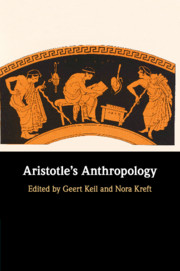Book contents
- Aristotle’s Anthropology
- Aristotle’s Anthropology
- Copyright page
- Contents
- Contributors
- Acknowledgements
- Introduction
- Part I Human Beings as Rational Animals
- Part II Human Nature in the Light of Aristotle’s Biology
- Part III Aristotle’s Moral Anthropology
- Part IV Aristotle’s Political Anthropology
- Bibliography
- Index
Part III - Aristotle’s Moral Anthropology
Published online by Cambridge University Press: 27 May 2019
- Aristotle’s Anthropology
- Aristotle’s Anthropology
- Copyright page
- Contents
- Contributors
- Acknowledgements
- Introduction
- Part I Human Beings as Rational Animals
- Part II Human Nature in the Light of Aristotle’s Biology
- Part III Aristotle’s Moral Anthropology
- Part IV Aristotle’s Political Anthropology
- Bibliography
- Index
Summary
Aristotle establishes in this passage a strong link between a substance’s ergon and its aretē.2 Ergon is commonly translated as ‘function’.3 In many cases, it is even conceived of as something’s function or purpose in the literal sense. At least this is how Socrates appears to define the term at the end of the Republic, book I, claiming that a substance’s ergon refers to the work for which the substance is the sole or best instrument (352e and 353a). Socrates’ reference to the pruning knife to cut vines is the paradigm case. While their shoots could also be cut with a carving knife, or a chisel, or many other tools, Socrates explains how no tool does it better than the pruning knife, which is made for the purpose. Thus, according to him, we are entitled to define the ergon or function of the pruning knife to be the act of pruning. As Socrates further states (353b), everything that has an ergon also has a distinct virtue (aretē) or vice (kakia). While it is through its virtue that it performs its ergon well, the opposed vice makes it perform its ergon poorly (353c). Socrates claims this model holds not only for artefacts such as the pruning knife, but more generally: In the same way it is attributed to the knife, it is also attributed to the eye, the horse, and the human being. Since artefacts are considered paradigmatic, we may call the Socratic model the functionalist conception of virtue. Virtue here means a substance’s fitness to serve a distinct purpose that is assigned to it; it means aptitude, serviceability, or even instrumentality.4
- Type
- Chapter
- Information
- Aristotle's Anthropology , pp. 161 - 218Publisher: Cambridge University PressPrint publication year: 2019

